
In Greco-Roman mythology, Aeneas was a Trojan hero, the son of the Trojan prince Anchises and the Greek goddess Aphrodite. His father was a first cousin of King Priam of Troy, making Aeneas a second cousin to Priam's children. He is a minor character in Greek mythology and is mentioned in Homer's Iliad. Aeneas receives full treatment in Roman mythology, most extensively in Virgil's Aeneid, where he is cast as an ancestor of Romulus and Remus. He became the first true hero of Rome. Snorri Sturluson identifies him with the Norse god Vidarr of the Æsir.
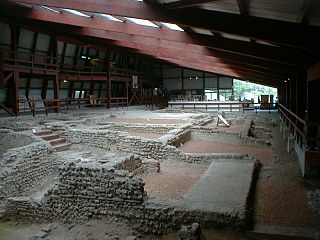
Lullingstone Roman Villa is a villa built during the Roman occupation of Britain, situated in Lullingstone near the village of Eynsford in Kent, south eastern England. The villa is located in the Darent Valley, along with six others, including those at Crofton, Crayford and Dartford. Constructed in the 1st century, perhaps around 80-90 CE, the house was repeatedly expanded and occupied until it was destroyed by fire in the 4th or 5th century. The villa was occupied over various periods within the Romano-British period, but after its destruction, it is only thought to have been reoccupied during the Medieval Times. The occupants were most likely wealthy Romans or native Britons who had adopted Roman customs.

A mosaic is a pattern or image made of small regular or irregular pieces of colored stone, glass or ceramic, held in place by plaster/mortar, and covering a surface. Mosaics are often used as floor and wall decoration, and were particularly popular in the Ancient Roman world.

High Ham is a village and civil parish in Somerset, England. Within the parish of High Ham are the villages of High Ham and Low Ham and the hamlets of Bowdens, Henley, Paradise and Picts Hill.

The Villa Romana del Casale is a large and elaborate Roman villa or palace located about 3 km from the town of Piazza Armerina, Sicily. Excavations have revealed one of the richest, largest, and varied collections of Roman mosaics in the world, for which the site has been designated as a UNESCO World Heritage Site. The villa and artwork contained within date to the early 4th century AD.

Chedworth Roman Villa is located near Chedworth, Gloucestershire, England and is a scheduled monument. It is one of the largest and most elaborate Roman villas so far discovered in Britain and one with the latest occupation beyond the Roman period. The villa was built in phases from the early 2nd century to the 5th century, with the 4th-century construction transforming the building into an elite dwelling arranged around three sides of a courtyard. The 4th-century building included a heated and furnished west wing containing a dining-room (triclinium) with a fine mosaic floor, as well as two separate bathing suites: one for damp-heat and one for dry-heat.
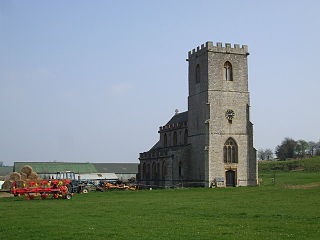
Low Ham is a village in the civil parish of High Ham in the English county of Somerset.
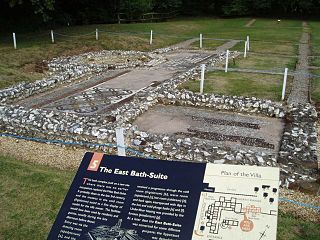
Rockbourne Roman Villa is a Roman courtyard villa excavated and put on public display in the village of Rockbourne in the English county of Hampshire. The villa was discovered in 1942 by a local farmer and excavated by A. T. Morley Hewitt over the next thirty years.

Brading Roman Villa was a Roman courtyard villa which has been excavated and put on public display in Brading on the Isle of Wight.
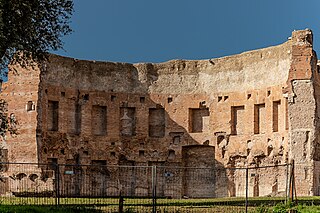
Bathing played a major part in ancient Roman culture and society. It was one of the most common daily activities and was practiced across a wide variety of social classes. Though many contemporary cultures see bathing as a very private activity conducted in the home, bathing in Rome was a communal activity. While the extremely wealthy could afford bathing facilities in their homes, private baths were very uncommon, and most people bathed in the communal baths (thermae). In some ways, these resembled modern-day destination spas as there were facilities for a variety of activities from exercising to sunbathing to swimming and massage.

Littlecote Roman Villa is an extensive and exceptional Roman villa, with associated religious complex, at Littlecote Park in Ramsbury, Wiltshire. It has been excavated and is on display to the public in the grounds of the estate.

The Museum of Somerset is located in the 12th-century great hall of Taunton Castle, in Taunton in the county of Somerset, England. The museum is run by South West Heritage Trust, an independent charity, and includes objects initially collected by the Somerset Archaeological and Natural History Society who own the castle.

The Museum of Mosaics is a museum in the town of Devnya in Varna Province, northeastern Bulgaria. The museum, built on top of a large ruined Roman villa from Late Antiquity, exhibits mosaics from the Roman and early Byzantine city of Marcianopolis, as well as other archaeological artifacts.

North Leigh Roman Villa was a Roman courtyard villa in the Evenlode Valley about 0.5 miles (800 m) north of the hamlet of East End in North Leigh civil parish in Oxfordshire. It is a scheduled monument in the care of English Heritage and is open to the public.
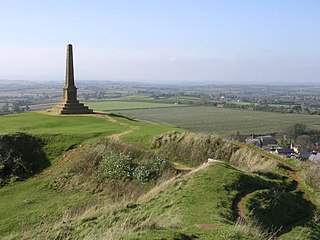
The Yeovil Scarplands are a natural region in southern England in the counties of Somerset and Dorset.

Folkestone Roman Villa, also referred to as the East Bay Site, is a villa built during the Roman Occupation of Britain, and is located in East Wear Bay near the port town of Folkestone, in Kent, England. The villa is situated on a cliff top overlooking the English Channel, with views of the French coast at Boulogne on a clear day. It is situated near the start of the North Downs Trackway, and the area has been inhabited for thousands of years, with archeological finds in the area and at the villa site dating back to the mesolithic and neolithic ages. The villa was built around A. D. 75, and was almost certainly built within the confines of a preexisting Iron Age settlement.
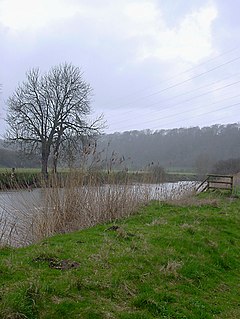
Keynsham Roman Villa refers to a cluster of villas built during the Roman occupation of Britain near Keynsham in Somerset, England. Two villas have been found, the larger of which is thought to be one of the grandest villas constructed in all of Britain. The sites have never been fully excavated, in part because portions of each are located underneath a cemetery, a major road, and the now shuttered Somerdale Chocolate Factory.

Narlıkuyu Mosaic Museum is a small museum in Narlıkuyu, Turkey that encompasses a Roman bath with a mosaic tile floor. The mosaic depicts the Three Graces.

Rudston Roman villa is a Roman villa and scheduled monument near Rudston, East Riding of Yorkshire.




















